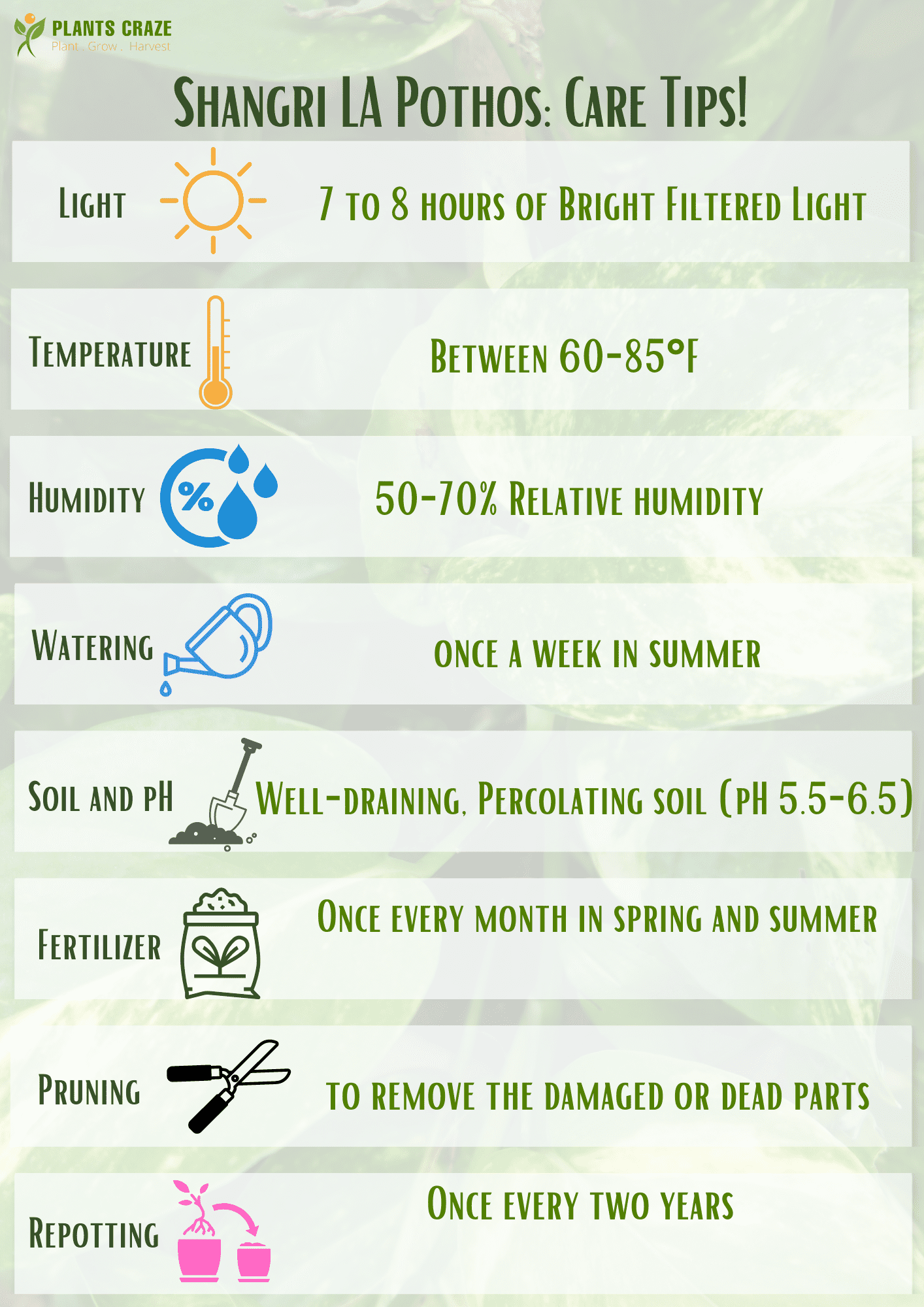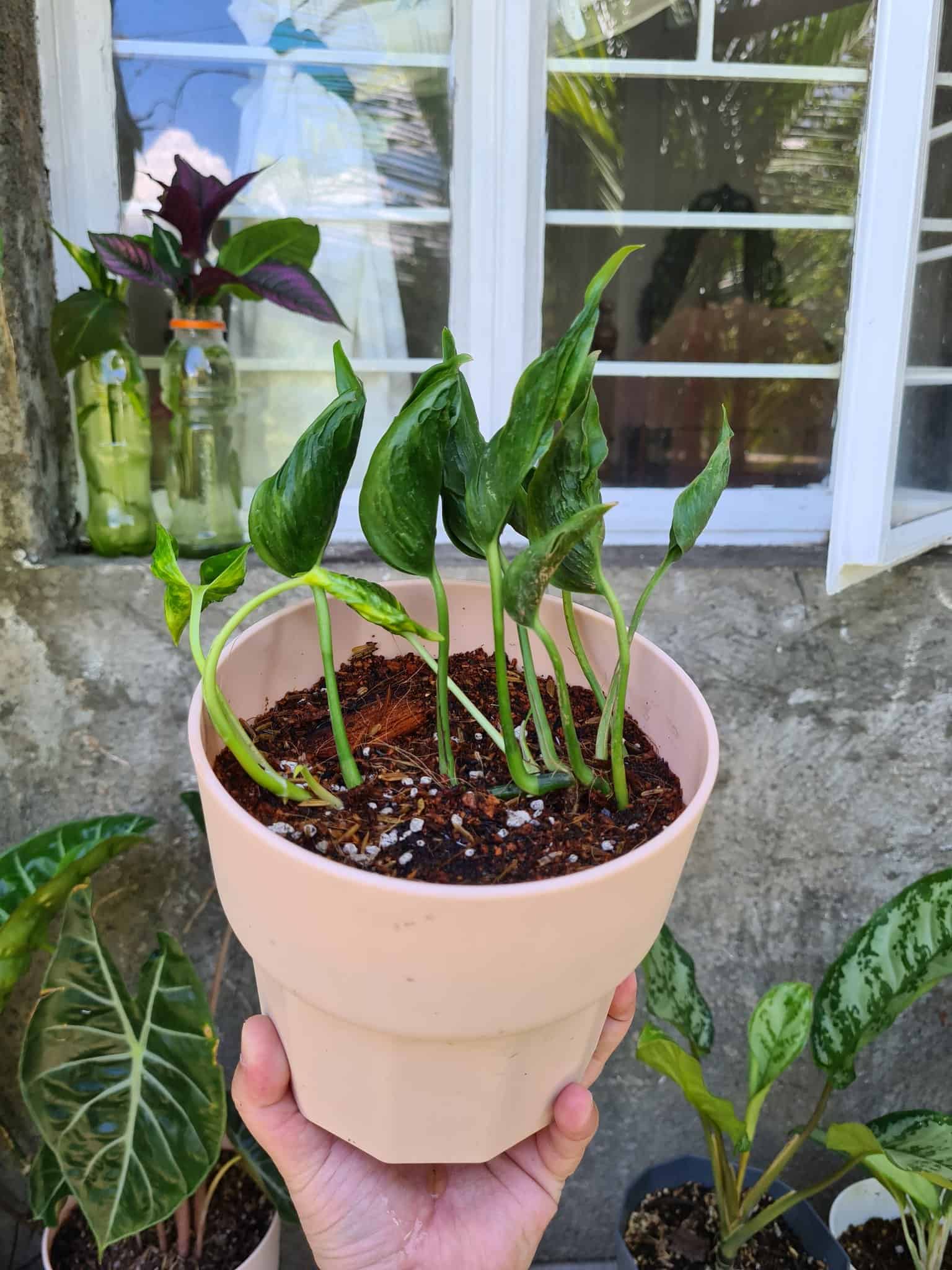Shangri La Pothos is a must-have variety for its uniquely shaped foliage that looks like closed eyes requiring simple and easy approaches to maintain.
Scroll till the end to understand the required condition for growth and easy solutions to the problems of Shangri La Pothos.
Table of Contents Show
Overview of Shangri La Pothos
The Shangri La Pothos is an inherent variety of the Golden Pothos with a light yellow variegation over the wrinkled, furled leaves.
| Identity | Indicator |
|---|---|
| Scientific Name | Epipremnum Aureum 'Shangri La' |
| Common Name | Sleeping Pothos Godzilla Pothos Spinach Pothos |
| Family | Araceae |
| Nature | Evergreen, Perennial |
| USDA zones | 10- 12 |
| Growth Habit | Vining-type |
| Growth Size | 6-8 feet |
| Flowering | Spadix of yellow to green color |
| Foliage | Dark green shiny leaves with yellow variegation Shriveled and closed leaves |
| Toxicity | Toxic to human and pets |
| Availability | Difficult to find |
A Complete Guide to Shangri La Pothos Care
Inadequate care of Sleeping Pothos affects the growth and health of the plant.
It is crucial to provide ideal growing conditions to keep the Pothos thriving and maintain their unique shape and lushness.

1. Sunlight and Temperature
Shangri La Pothos variegated is a temperature-sensitive plant loving bright indirect light for 7 to 8 hours daily with a temperature of 60-85ºF.
So, place the plant in an east or north-facing window where they can receive little early morning sunlight and indirect light throughout the day.
However, maintain light intensity and temperature as it should not be too low, causing cold drafts <50ºF, leading to stunted and leggy growth.
Install grow lights for dark rooms and heat mats under the pot to protect them from cold, or cover them with a frost blanket for safety.
Meanwhile, mist the plant if the temperature ranges >95ºF as it will cause the leaves to burn but do not overdo it.
Alert: Keep the Shangri La away from the radiators and vents to prevent the plant from experiencing a fluctuating temperatures.
2. Water & Humidity
The ideal watering frequency for Shangri La Pothos is once a week in summer and once in two weeks during winter seasons with a humidity of 50-70% in check.
Shangri La Pothos doesn’t like soggy conditions and high humidity as it invites fungal growth and root rot with mushy yellow leaves.
However, do not let the soil turn compact while maintaining the dryness, as the leaves will turn crisp when aided by low humidity.
Control the water using a mini watering can or spray bottles to promptly avoid contact with the foliage and mist the plant 2-3 times weekly.
Install an electric humidifier, and apply the bottom watering approach or humidity trays to balance the moisture level and humidity in the soil and air.
3. Soil & Fertilizer
Shangri La Pothos can grow both in water and soil, but growing in well-draining soil rich in organic matter is more rewarding as it becomes bushier.
Keep the soil slightly acidic (5.5-6.5 pH) and porous by adding sphagnum moss, and avoid clayey soil as they hold water for a longer time.
You can also buy appropriate planting mixes like Air Cleaning Plant Soil, Burpee Premium Organic Soil, Miracle-Gro Indoor Mix, and Devils Ivy Planting Soil online.
The online mixes have sufficient nutrients for Pothos, so you need not fertilize them for at least six months but provide monthly feeding with diluted liquid fertilizer to the DIY mix.
However, Shangri La Pothos are light feeders, and overfertilization is common, causing salt build-ups and burning of the stems.
So remember to water the plant immediately after fertilization to let the nutrients reach the soil quickly or use slow-releasing fertilizer.
Pothos does not need fertilizer during the winter season. However, feeding once during entire winter may help keep the plant healthy.
4. Potting & Repotting
Choose a pot 2-3 inches wider than the Pothos root ball to provide adequate airflow, drainage, and moisture control.
A ceramic or terracotta pot with at least one drainage hole is best for Shangri La. You can also go for plastic or cemented ones but avoid metal or glass pots.
Doing so, you can forgo the repotting for at least two years, but after the time break, the roots poke from the drainage holes and show stunted growth.

Start by watering the plant thoroughly for easy removal of the plant a day before repotting.
Pull off the plant from the pot by holding it on the base or turn the container upside down for easy removal.
Discard one-third of the soil from the root ball, trim the long and diseased roots, fill a new pot up to two-thirds with fresh potting mix, and plant the Pothos.
Then fill the container, place it in bright indirect light, and thoroughly water the plant.
Don’t panic if the plant appears wilted, as it will revive with its dark green shiny leaves in a week.
5. Occasional Pruning
Prune the yellow, damaged, and infected leaves of Shangri La monthly to keep them neat, healthy, and bushy and control the height of the plant.
So better to spray neem oil or insecticidal soap as soon as you notice them and trim off the damaged leaves to allow healthy growth.
The Shangri La Pothos can also be infested by common diseases like Root rot, Damping off, Southern blight, Bacterial wilt and Bacterial leaf spot.
You can identify their presence by looking at the wilted leaves, mushy roots, brown or black lesions in leaves and stems, and discolored black veins.
Immediately isolate the plant, trim off the affected parts, and use copper fungicides occasionally.
It is best to prune your Pothos at the beginning of spring when the plant’s growth begins again after the dormant period.
Growth Habit and Foliage: Shangri La Pothos
Shangri La Pothos has a slow to moderate growth rate attaining a height of 6-8 feet outdoors while 3-5 feet as an indoor plant.
They have vine-like growing habits that may creep or climb, needing the support of a moss pole, based on where you keep them.
Some people define its foliage color as cooked spinach, hence named Spinach Pothos.
Also, Shangri La Pothos produce yellow to green flower spikes when grown in their natural habitat after reaching maturity.
However, Sleeping Pothos grown indoors bear flowers very rarely. So, you will have to provide it with the ideal growing condition to enjoy its flower throughout the year.
Toxicity of Shangri La Pothos
Even though the beauty of Sleeping Pothos is eye soothing, you’ll have to keep it far from the reach of pets and children.
As per the ASPCA, the direct parent of Shangri La, Golden Pothos contains Calcium Oxalate Crystals, making the Sleeping Pothos also a toxic plant.
Therefore, place the plant over a shelf or in a hanging basket to keep the pets and children away from their reach.
Here are the immediate helpline number to contact if the symptoms persist in your pets and toddlers from plant poisoning.
- Pet Poison Helpline: (855) 764-7661
- Animal Poison Control Center(APCC):(888) 426-4435
- Poison Control:(800) 222-1222
Propagating Shangri La Pothos
Consider propagating your Sleeping Pothos during the spring or early summer to allow plants to grow roots faster.
You can use two different mediums to propagate them: water and soil.
But initially, take the stem cutting without hurting the parent plant.
- Select the stem that is healthy and has few leaves.
- You will have to remove some leaves to expose the root nodule to get a cut.
- Cut the stem about a quarter inch below the node to get about 4-6 inches long, using a sterilizer scissor or pruner.
1. Propagation in Water
- Choose a transparent glass jar and clean it with isopropyl alcohol to remove any attached bacteria.
- Then, fill the jar with tepid water and place the cutting. Ensure that you use non-chlorinated water.
- Place the cutting in a site with bright indirect light and change the water in the jar every 3-5 days.
When the roots become about an inch long in about 1-2 weeks, you can transfer the cuttings to a fresh potting mix.
2. Propagation in Soil Medium
Before starting, dip the lower end of the cutting in a rooting hormone. However, it is an alternative as the cutting can develop naturally without a booster.
- Take a fresh potting mix in a pot and plant the cutting.
- At least one node should be covered in the soil. But ensure any leaves aren’t buried.
- Water the cutting and put it in a well-lit place.
- Cover the pot with plastic with holes to increase the plant’s humidity.
The cutting will develop roots in about a month. Provide general care similar to the mature plant to the baby Shangri La Pothos.
Additionally, you may as well grow the Pothos from seeds. However, it takes a long time to show positive results.
Take reference for a visual aid!
Shangri La Pothos for Sale
After learning all the care tips, you are ready to bring a new Shangri La home. Look at the sites to buy them.
| Shops | Delivery Time |
|---|---|
| Gulley Greenhouse | 7 days or more depending on location |
| Etsy | 12-26 business days |
| Jordans Jungle | 5-7 business days |
FAQs About Shangri La Pothos
What is Shangri La Pothos?
Shangri La is a cultivar of Pothos from the Golden Pothos, for which they have yellow variegation over the shriveled, furled green leaves.
Is Shangri La Pothos Rare?
Variegated Shangri La Pothos is rarely found in nursery stores, so you will have to order from online stores to get them. However, they are not listed as rare plants in the IUCN red list of threatened species.
Final Thought
Shangri La Pothos is one of the unique Pothos out there. Growing this uniquely beautiful plant is easy and highly satisfying because of its adorable leaves.
Provide the essential requirement of indirect bright light, warm temperature and moderate humidity, and you will be an owner of thriving Pothos.


